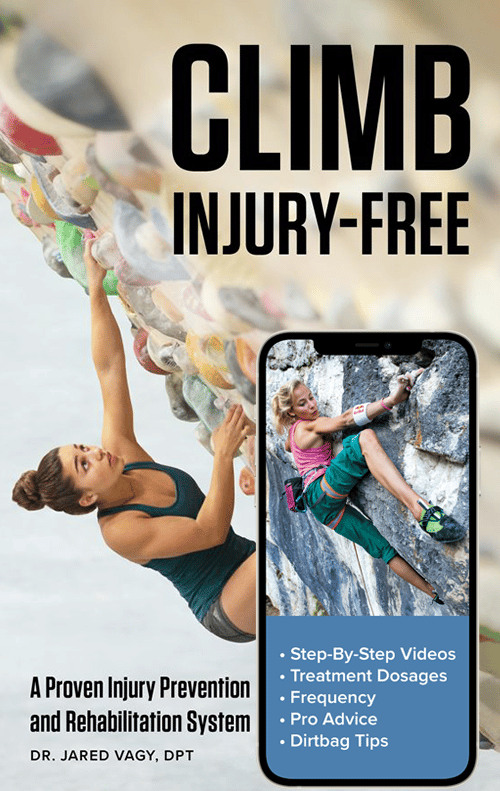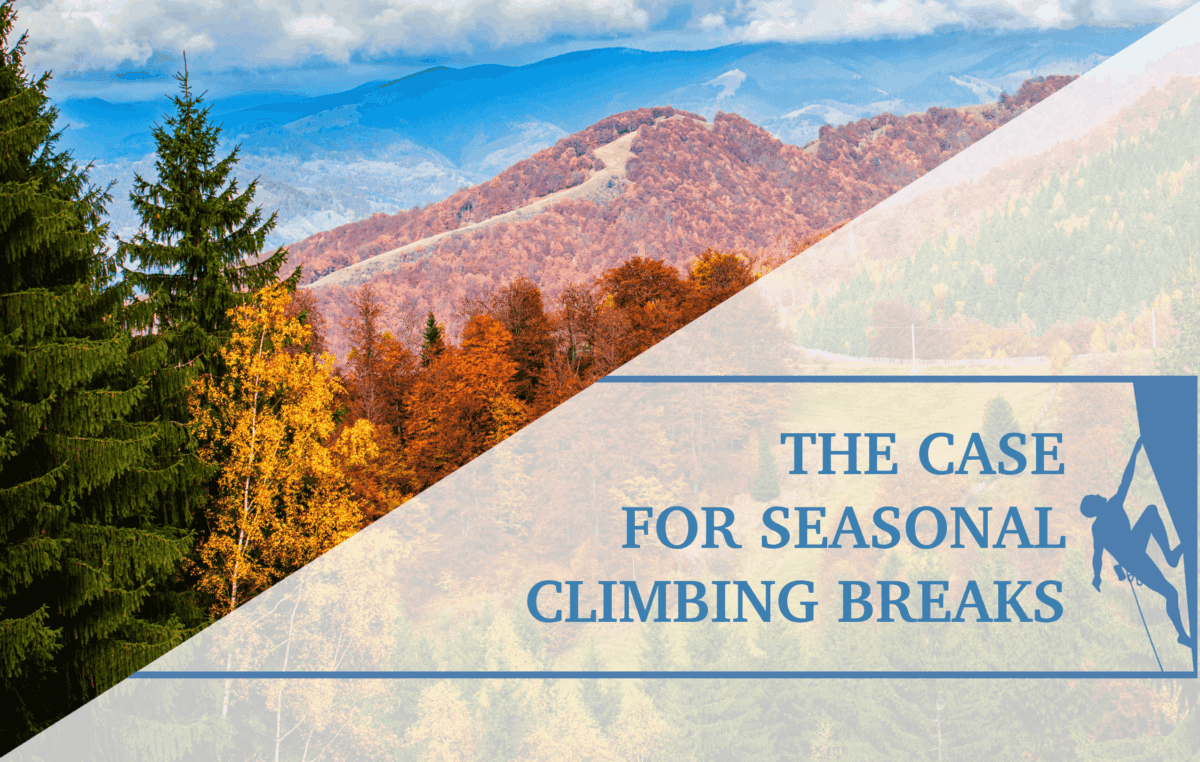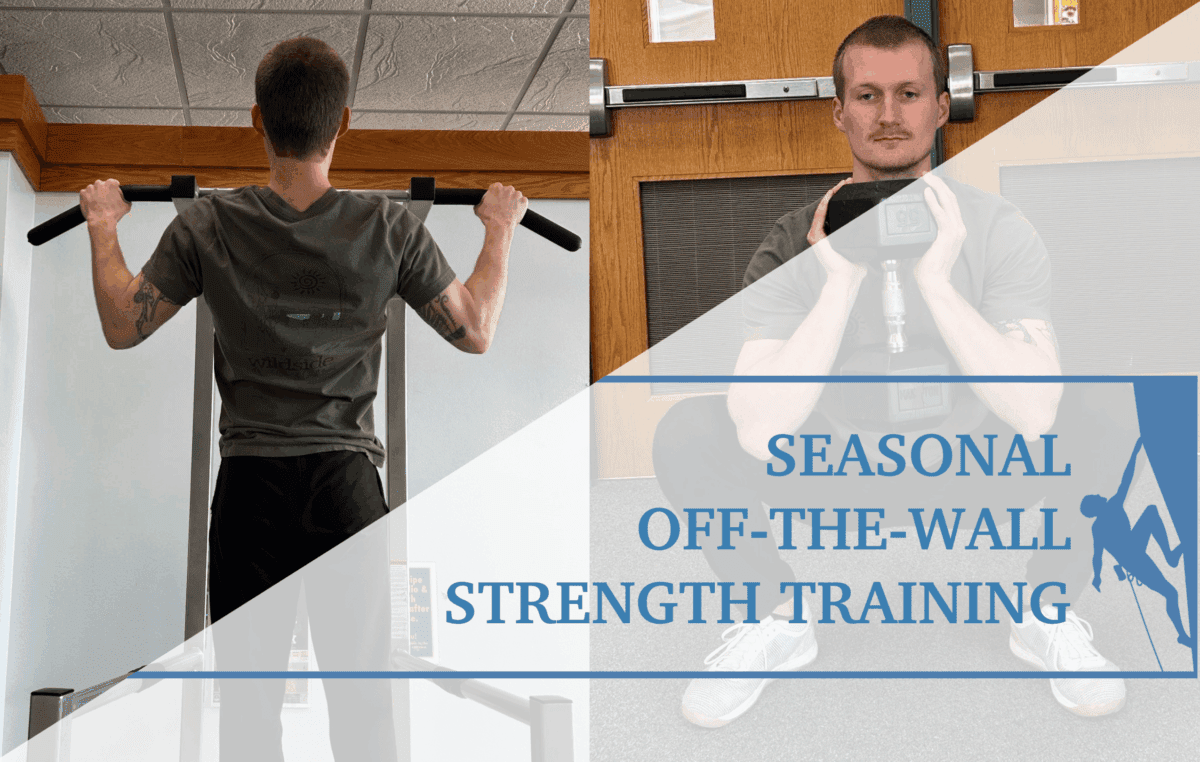Brain, Body, and Beta-Miming
How neurocognitive training can improve your performance and help you rehab smarter. Finally, your obsession with beta has science to back it up. We have all seen videos of Adam Ondra in his dreamstate, flat on his back, arms and legs flailing in the air as he rehearses intricate climbing sequences with manual feedback from his physiotherapist. And we’ve all likely been at the gym, standing at the base of our project with varying degrees of subtle or exaggerated arm movements, beta-miming our way through a challenging sequence in some last-ditch effort to commit it to memory before pulling on for the 10th time. Obviously Ondra finds some success with these tactics, and I have certainly experienced my own share of being able to pull onto the wall more rested and more focused after visualizing my beta. But what is behind this phenomenon? Is it all in our heads? Or is there something changing neurologically and physically when a climber takes the time to visualize their climb move for move before making contact with the wall? Does motor imagery and kinesthetic pre-practice of movement actually help our climbing performance once we are on the wall? If so – how?
The more we learn about neuroscience and physiology, we are realizing how interconnected the brain and the body really are. With more insight into what drives neuroplasticity and psychoneuromuscular theories, we are learning how motor imagery (MI) may lead to changes in the pathways between our central nervous system (brain and spinal cord) and our musculoskeletal system in a very similar way as when we physically practice a skill.

We are also learning how important it is to incorporate neurocognitive and motor imagery training into rehab plans to make sure that we are retraining our brains’ involvement in proprioception, stabilization and integrating cognitive load which gets damaged with injury.¹ So with all this in mind, let’s dive deeper into how you can use motor imagery training to optimize your climbing performance both in health and when rehabbing from an injury.
Beta Miming (ie: visualization and motor imaging): what it is and how does it work?
We commonly experience the phenomenon of building “muscle memory,” where through practice of certain movements and techniques they slowly become more automatic. This then frees up the mental and physical space for us to learn new and even more complex sequences of movement. Motor learning and the adaptive neuroplasticity (the neural changes that are accomplishing the goal that we are trying for) that happens to solidify these motor plans in our brains is essential to efficient and skilled movements.² When applying these general principles to climbing, we often don’t have enough time, or skin, to physically try a sequence over and over again until we are finally able to commit the moves to memory to make them automatic. The term “beta miming” refers to the practice of visualizing yourself climbing and rehearsing the moves before actually pulling onto the wall. There are a few different versions of visualization but all generally engage similar neural pathways and lead to similar results. This article will focus on kinesthetic motor imaging which incorporates the sensations of the environment AND the imagined tactile feedback from both the outside world and the sensations from your own muscles and joints while you are moving your body.]
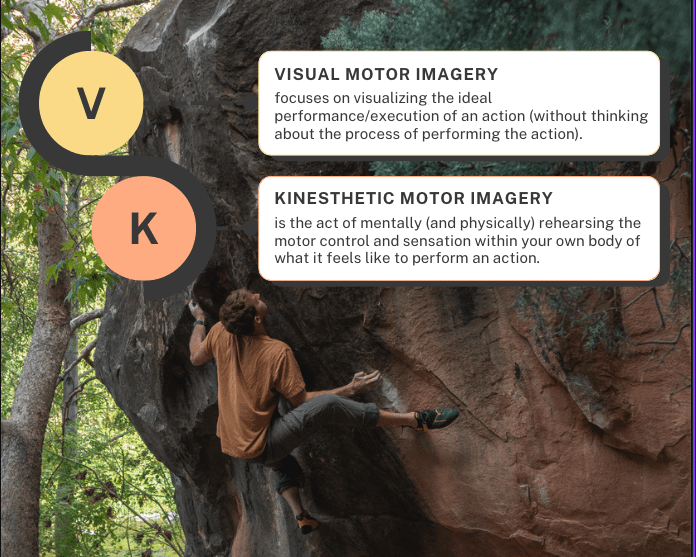 While there is a lack of climbing specific research into kinesthetic motor imagery for improving performance, it has been well-studied in other sports as well as for recovery of function after neurological injuries. These insights can be easily applied to rock climbing. To understand how kinesthetic motor imagery actually works we need a brief neuroscience lesson.
While there is a lack of climbing specific research into kinesthetic motor imagery for improving performance, it has been well-studied in other sports as well as for recovery of function after neurological injuries. These insights can be easily applied to rock climbing. To understand how kinesthetic motor imagery actually works we need a brief neuroscience lesson.
Researchers from various studies have observed the brains of subjects through fMRI (imaging that looks at brain function – as opposed to the static structure as viewed by traditional MRI).³ The fMRIs were observed while they were participating in various visualization exercises and observed activation of areas of the brain that have crucial roles in motor learning and planning. During motor imagery activities, participants are activating these same neural circuits and are in some ways “feeling” how the imagined motion would affect their body by engaging the same neural pathways.³ These neural circuits include the premotor cortex, supplementary motor area, the cerebellum and the basal ganglia which are all essential in motor planning, motor control and coordination during movement. The caudate, a portion of the basal ganglia, is another structure that is intricately linked to the utility of visualization. The caudate has three important tasks that make it vital for kinesthetic imagery especially. The caudate “(a) provides balance to limbs and body which allows participants to produce accurate and fast movements in their own minds,” “(b) it helps decision-making in goal directed behaviors,” and “(c) it integrates spatial localization with planned motor behavior, and serves as a hub to plan more accurate and efficient motions due to its role in spatial working memory.”³
Motor imaging (MI) and neuroplastic changes:
As you can see, there is a LOT happening behind the scenes to plan out and coordinate the accurate and full-body performance of a task even BEFORE we actually perform a movement. We are activating the same structures when we are visualizing ourselves performing a task as when we are actually physically performing the task.⁴ ⁵ We know from the central tenets of motor learning that repetitions of a task cause lasting neuronal changes called adaptive neuroplasticity.⁶ Neuroplasticity changes can increase the efficiency of those particular motor pathways and make us better at performing those skills.⁶ Essentially these repetitions are giving our brain-body connection more chances to solidify those pathways of activation, making them the more automatic choice when confronted with a motor “problem” to solve. The more repetitions that you are able to get on any given movement pattern, the “stronger” the neuroplastic changes will be for any given sequence or task. Through current research we are seeing that repetitions of motor imaging training can cause similar neuroplastic changes, without the tissue fatigue and wear and tear of physical repetitions.
How injury affects our brains:
Now let’s talk about how MI can help rehab from injury more efficiently. When an athlete is injured, there is so much more involved than just the 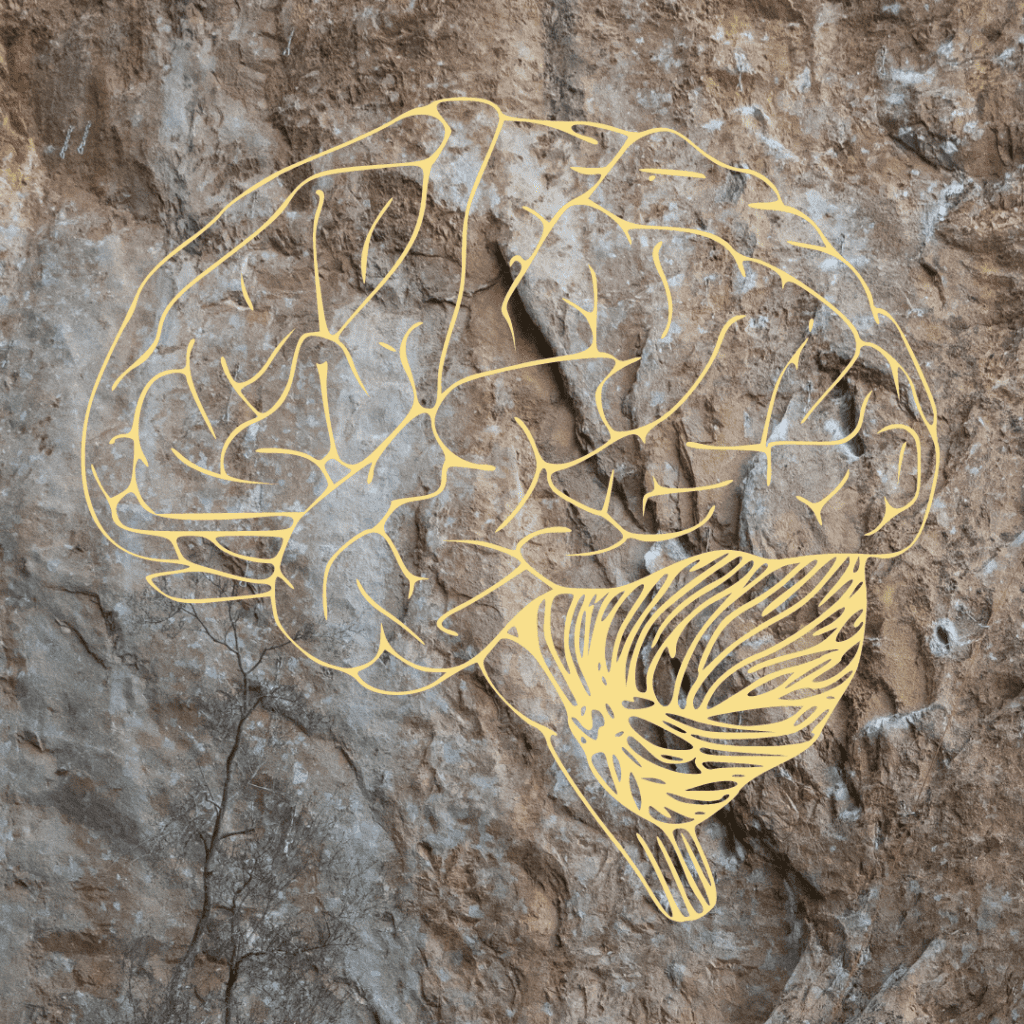 mechanical change to the tissue itself. There are actual changes in the way that the regions of the brain (especially the parietal and occipital lobes as well as the pathways involved with MI training), receive and respond to environmental stimuli.⁷ We are seeing how injury “alters how the nervous system generates movement and maintains dynamic joint stability. The post injury neuroplasticity can cause neural compensations that increase reliance on neurocognition” during activities.⁷ These changes force the athlete to use compensatory strategies and use more mental energy to perform activities that used to be automatic.⁷ So injury to a tissue decreases the automaticity of proprioception and the body’s ability to maintain dynamic stability in and around a joint. The research is showing that athletes are returning to their pre-injury level of sport and have a lower rate of re-injury after using mental training along with their physical rehabilitation. With this in mind, why wouldn’t we incorporate motor imagery training of climbing movement early on in the rehabilitation process (and progress it later on in rehab) to start re-connecting those associative pathways in the brain without putting unnecessary stress on the healing tissues? So when you are trying to come back to full climbing, you need to make sure you are flexing your cognitive integration right along with your sport-specific rehab for the injured tissue.
mechanical change to the tissue itself. There are actual changes in the way that the regions of the brain (especially the parietal and occipital lobes as well as the pathways involved with MI training), receive and respond to environmental stimuli.⁷ We are seeing how injury “alters how the nervous system generates movement and maintains dynamic joint stability. The post injury neuroplasticity can cause neural compensations that increase reliance on neurocognition” during activities.⁷ These changes force the athlete to use compensatory strategies and use more mental energy to perform activities that used to be automatic.⁷ So injury to a tissue decreases the automaticity of proprioception and the body’s ability to maintain dynamic stability in and around a joint. The research is showing that athletes are returning to their pre-injury level of sport and have a lower rate of re-injury after using mental training along with their physical rehabilitation. With this in mind, why wouldn’t we incorporate motor imagery training of climbing movement early on in the rehabilitation process (and progress it later on in rehab) to start re-connecting those associative pathways in the brain without putting unnecessary stress on the healing tissues? So when you are trying to come back to full climbing, you need to make sure you are flexing your cognitive integration right along with your sport-specific rehab for the injured tissue.
How motor imagery elevates performance in other sports:
When looking at soccer training for novice and advanced soccer players, groups using both visual and kinesthetic motor imagery training (in addition to their physical training) showed a decrease in response time for performing sequences of movement.⁸ In fact, especially after a period of detraining, the consistent use of MI is useful for expediting strength and power performance in both the lower and upper extremities, in comparison to strength and power training alone.⁹ It seems that athletes utilizing MI in their training not only learn sequences of movement faster but also are able to more rapidly and increase their strength and power while performing those movements. Why wouldn’t it be the same for rock climbers?
HOW IT APPLIES to CLIMBING:
How to actually do it…
So what does all of this mean for your climbing? When you boil it down, the research is all pointing towards the fact that to optimize training (whether it be strength, skill or rehabilitative training), you really should be incorporating motor imagery training alongside your physical training.
Below are some big takeaways and reminders from the research and details about how to apply these principles to optimize your physical training and rehab.
Big Takeaways for Using Motor Imagery:¹⁰ ⁵
- MI should be used alongside physical training whenever possible, not instead of.
- Visualizing yourself performing an activity is better than visualizing someone else performing the activity.
- Visualization and motor imaging training sessions need to be brief (around 15-20s each) and repeated over and over again.
- To get the real benefits of MI training, you are going to need a lot of repetition. Try to incorporate MI throughout your day and train as much as you can. The more the better.
- Keep your motor visualization scenario as close to the real-world scenario as possible. This includes the tempo of the sequence and all the details of the environment, etc.
- Progress and increase MI training complexity and change skills once you see good transference to real life performance.
- Focus on the feels. How do the moves feel in your body, how you feel while doing the movement (both physically and emotionally), and how the environment around you will feel while climbing.
- Make it multisensory when possible. Add audio, video, tactile feedback, etc. This helps to increase the cognitive load and mimics the real-world challenges.
- Keep the tasks simple at first, and increase complexity as the real-world application becomes better.
How to Apply It: (There are so many ways to incorporate motor imagery to your training. This is just a start!).
- Visualization and motor imagery exercises to optimize performance:
- Audio-guided visualization: If you are struggling with a sequence on a route, take the time in the days leading up to trying the route again to record yourself verbalizing 15-20s of your beta through the sequence. Then periodically throughout the day, play the recording, close your eyes and physically move your limbs through the sequence, thinking about the following:
- How do the holds feel?
- How much effort are you going to have to use to make each move?
- How are you breathing? (practice appropriate breathing techniques while visualizing)
- Where are you shaking out? (actually shake out when you get to that point)
- Where are you putting your weight?
Repeat as many times throughout the day as you are able.
- Beta-mime it: Before pulling on a new boulder problem at the gym, take a second and visualize what you think your beta will be for the climb. Then take the next step of physically beta-miming your way through the sequence, including changing your body positioning, visualizing yourself making that explosive move, and taking it all the way to the top. Then pull on and give it a try. Didn’t work? Use the information that you gained from that experience, beta-mime an alternative with a more detailed understanding of the route, and then pull on again.
- **Go a little deeper and make sure you are using the PETTLEP approach.⁵
- Listen to a recording or verbalize in the moment various beta sequences while performing rehab exercises. Don’t just be thinking about doing the task, be thinking about how you are going to move through a sequence.
**Change things up. Keep yourself guessing, problem-solving, and cognitively engaged with each of these tasks
- Audio-guided visualization: If you are struggling with a sequence on a route, take the time in the days leading up to trying the route again to record yourself verbalizing 15-20s of your beta through the sequence. Then periodically throughout the day, play the recording, close your eyes and physically move your limbs through the sequence, thinking about the following:
See a Doctor of Physical Therapy
Especially when it comes to injury rehabilitation, having a physical therapist in your corner is a leg up to help you get back quicker to the activities that you love. If you just got injured and need an evaluation, or if you are far down the rehab road but just aren’t back to where you want to be, consider seeing a PT in your area. Rehab and performance optimization is a tricky balance of overloading the brain and body just enough to cause growth, but not enough to re-injure. PT’s are movement specialists, with a keen understanding of how the brain affects the body and vice versa. If you let us, PT’s can play an integral role in unlocking motor imagery and cognitive training to enhance your physical training and rehab plan, helping you reach your full potential as an athlete.
Author Bio
Anna Chleboun is a second year graduate student in the DPT program at Northern Arizona University in Flagstaff, AZ. Her main interests are in orthopedic, (outdoor) sports and neurological PT. Fascinated by the unique demands of healthcare provision for rock climbing and mountain athletes, Anna’s capstone project is titled Scaling New Heights: Effective Treatments and Holistic Exploration of Rehabilitation in Rock Climbing Injuries (ETHER). Anna is currently a TA for the NAU DPT clinical anatomy class and is a part of the Climbing SIG.
Anna loves taking advantage of the incredible sport climbing in the desert surrounding Northern Arizona on the weekends, going backcountry skiing when possible, and keeping up on her trail running. With a background in nonprofit management, dance and Pilates, Anna is interested in finding creative, practical, and low-cost ways for athletes (and everyone) to address and understand their pain, move more efficiently, and prevent injury all while pushing their potential doing the things that they love.
References
- Chaaban CR, Turner JA, Padua DA. Think outside the box: Incorporating secondary cognitive tasks into return to sport testing after ACL reconstruction. Front Sports Act Living. 2023;4:1089882. Published 2023 Feb 15. doi:10.3389/fspor.2022.1089882
- Mulder T. Motor imagery and action observation: cognitive tools for rehabilitation. J Neural Transm (Vienna). 2007;114(10):1265-1278. doi:10.1007/s00702-007-0763-z
- Filgueiras A, Quintas Conde EF, Hall CR. The neural basis of kinesthetic and visual imagery in sports: an ALE meta - analysis. Brain Imaging Behav. 2018;12(5):1513-1523. doi:10.1007/s11682-017-9813-9
- Ridderinkhof KR, Brass M. How Kinesthetic Motor Imagery works: a predictive-processing theory of visualization in sports and motor expertise. J Physiol Paris. 2015;109(1-3):53-63. doi:10.1016/j.jphysparis.2015.02.003
- Holmes PS, Collins DJ. The PETTLEP approach to motor imagery: a functional equivalence model for sport psychologists. J Appl Sport Psychol. 2001;13(1):60–83.
- Schneider, E. (2023, August 31). The 10 principles of neuroplasticity will help you hike your project. Climbing. https://www.climbing.com/skills/neuroplasticity-principles-for-athletes/
- Grooms DR, Chaput M, Simon JE, Criss CR, Myer GD, Diekfuss JA. Combining Neurocognitive and Functional Tests to Improve Return-to-Sport Decisions Following ACL Reconstruction. J Orthop Sports Phys Ther. 2023;0(8):1-5. doi:10.2519/jospt.2023.11489
- Blair A, Hall C, Leyshon G. Imagery effects on the performance of skilled and novice soccer players. J Sports Sci. 1993;11(2):95-101. doi:10.1080/02640419308729971
- Dello Iacono A, Ashcroft K, Zubac D. Ain’t Just Imagination! Effects of Motor Imagery Training on Strength and Power Performance of Athletes during Detraining. Med Sci Sports Exerc. 2021;53(11):2324-2332. doi:10.1249/MSS.0000000000002706
- Huberman, A. (2023) Science-Based Mental Training & visualization for improved learning. Huberman Lab. 2023. Available at: https://podcastnotes.org/huberman-lab/science-based-mental-training-visualization-for-improved-learning-huberman-lab/. Accessed: 07 January 2024.
- Disclaimer – The content here is designed for information & education purposes only and the content is not intended for medical advice.

